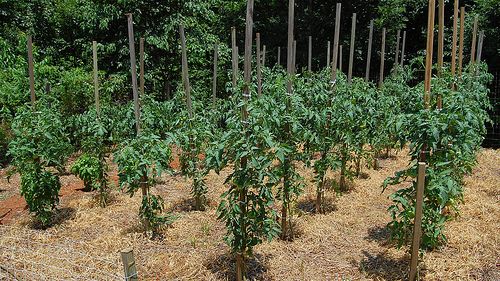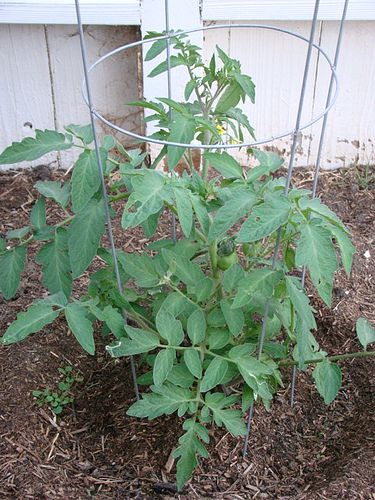
February is prime time for starting vegetable seeds indoors in preparation of spring planting. Among the tons of veggies started this winter, probably the majority of those will be tomato seeds. For those that are wondering which tomato plant characteristic is right for them, here are some thoughts on the bush and vining types.
Determinate or indeterminate?
Tomato plants generally fall into two categories: determinate and indeterminate. Determinate (bush) tomato plants are bred to stop growing usually somewhere around 3′-4′ feet tall. When flowers blossom at the tips of the branches, the plant has reached its full height. The fruit of a determinate tomato plant ripens all at once. Because of this trait, this type of tomato plant is useful for those who want to grow tomatoes for canning. Since many determinate plants stay on the short side, they can also be ideal for the small-space gardener.
Indeterminate tomatoes continue to grow for what seems like indefinitely. Depending on the variety, they can grow from 6′-20′ tall. This type continues to produce tomatoes all growing season until a hard frost hits and stops them in their tracks. These plants are particularly desirable if you’d like a continuous harvest for slicing or salad tomatoes. Although, indeterminate tomatoes can be used for canning just like the determinates, you may need a few more indeterminate plants so that you have plenty to can at any one time.
Stakes or tomato cages?
Cages and stakies are the easiest and fastest type of structures for vertical veggies such as tomatoes or peppers. While these plants need something to “climb”, they’re not true vines and should have their branches supported by being tied periodically to keep them upright.
| All About Tomatoes | |
 |
|
| Learn more about types of tomatoes, selecting, pruning, and planting tomatoes, tomato support systems, and tomato recipes… |
Caging is the simplest way to support tomatoes and is the perfect solution for determinate varieties. Tomato cages can work well for the indeterminate, too, but staking seems to offer the best support for the vining types. Staking tomato plants is an excellent way to keep the plants upright and the fruit off of the ground. Scrap wood, bamboo, or metal can be used as stakes.
If you use the staking method, you’ll have to have some type of tying material to attach the plants to the stake at regular intervals while they’re growing. Ties can be made of torn fabric, twist-ties, or plastic ties. Also, pruning indeterminate tomato plants is the best way to make the most of staked plants.
I tend to grow indeterminate tomatoes far more than their determinate counterparts. However, this is more due to the fact that I also predominately grow the heirloom varieties and most heirlooms are indeterminate plants.
Fine Gardening Recommended Products

A.M. Leonard Deluxe Soil Knife & Leather Sheath Combo
Fine Gardening receives a commission for items purchased through links on this site, including Amazon Associates and other affiliate advertising programs.

Gardener's Log Book from NYBG
Fine Gardening receives a commission for items purchased through links on this site, including Amazon Associates and other affiliate advertising programs.

Chapin International 10509 Upside-Down Trigger Sprayer
Fine Gardening receives a commission for items purchased through links on this site, including Amazon Associates and other affiliate advertising programs.



















Comments
Log in or create an account to post a comment.
Sign up Log in